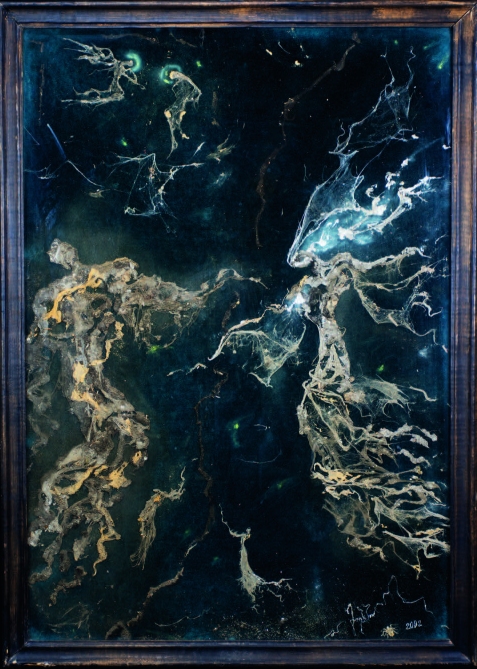
Image Copyright Ia Mghebrishvili, used with permission
For too long I haven’t written about faith. For too long I haven’t written of the sea. There’s something of both in the cobweb creations of Ia Mghebrishvili. She is a Georgian painter who you might at first see as a Gothic artist, or as a spiderweb-painting student of the macabre. I understand the assumption; there is a shade of death associated with many elements of her paintings. There are dark places in her frames, but I’ve always thought symbolic darkness makes more sense representing neutrality, not villainy, while color is chaos made visible, more than divinity. To assume something is Gothic by the fact that it is dark is to simplify it as you might do by saying the rebirth of Lazarus was casual Necromancy.
You will clearly see that Ia’s paintings draw inspiration from biblical imagery, thus, they are clear and utterly intentional, but she tells familiar stories while only very rarely using any shape that could not exist on its own in the natural world. The eye-catching quality of her paintings comes from a heavy focus on the beauty of opposites. Light and dark, good and evil, the use of delicate, impermanent material to create scenes that evoke immortality. It’s an almost turbulent coalescence of folklore and faith that must appear different depending on who you are looking at it, and what faith you have in the world around you.
I spoke of the sea.
Amidst the light and dark of her paintings, there are colors she uses that transport me to the seashore I hold in my mind, where I am collecting iridescent shards of abalone, looking out and wondering on the unutterable darkness beneath the waves where her paintings suggest to me there might be something more.
Standing at that edge where land, sea, and sky converge seems a good place to wonder about heaven and earth in the same thought. Thoughts of Angels lead me wandering into thoughts of other entities, from the Old Stories. Her imagery draws from biblical things, as I said, but it also evokes the commonality between ancient faiths and folklores. In biblical visualizations I usually see the idea of heaven shown as completely timeless invulnerability, but Angels made of webs allude to the beauty of being both of the heavens and of the earth, and when I look at these Angels I see wind in their shapes that evoke a broad sky, organic substance that makes me think of the impermanent Earth, and colors that whisper about the Ocean; a darkness from which all things are born.
Some must see Lazarus. Or Abraham.
I see faeries in these lines, peeking out beneath halos, wondering how they came to be face to face with me when a moment ago I was reading a different story. But I see what I see, and I see spirits living in the lightless microbial snow of the deepest places in the world, hanging there in the dark waters, and I wonder what faeries might live twenty thousand leagues beneath the feet of the Son of God.
Maybe that’s what Gothic art means at this moment; not endeavoring towards morbidity but just being willing to look into the places often unseen – I changed my mind – I can see Ia Mghebrishvili as a Gothic artist; a Gothic painter with a divine mandate to sculpt angels out of spiderwebs.
In writing introductions for artists I haven’t met, I unavoidably become excited to meet them at Art! Vancouver. As I began this paragraph, I’ve learned Ia passed away in March 2010. Her work is, kindly, being presented at our show by those entrusted with it.
So when I would normally invite you to come and engage with our artist, I suddenly find I can’t. I will say that what happens when an artist leaves behind an exceptional body of work, is that we begin the process of preserving their voice to the extent we are able, but with no new work forthcoming, the chance to see those paintings begins to, slowly, wane. Don’t miss the opportunity. You will see in her work whatever you need to see in her work. It might be as Lazarus risen in exaltation to a greater power, or it might simply be as a silken Jesus asking if you would choose to walk on the surface when given the opportunity to go below.
Don’t forget to LIKE and COMMENT at the bottom!

